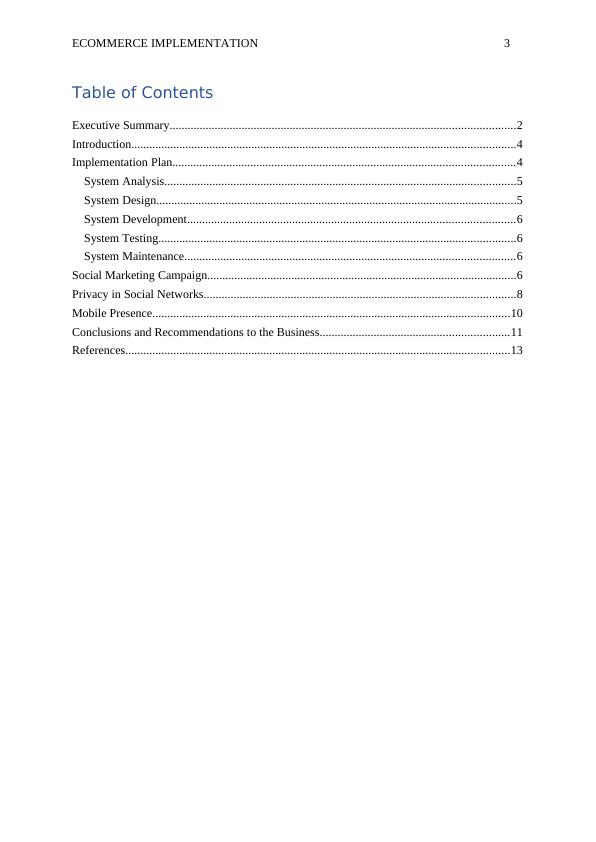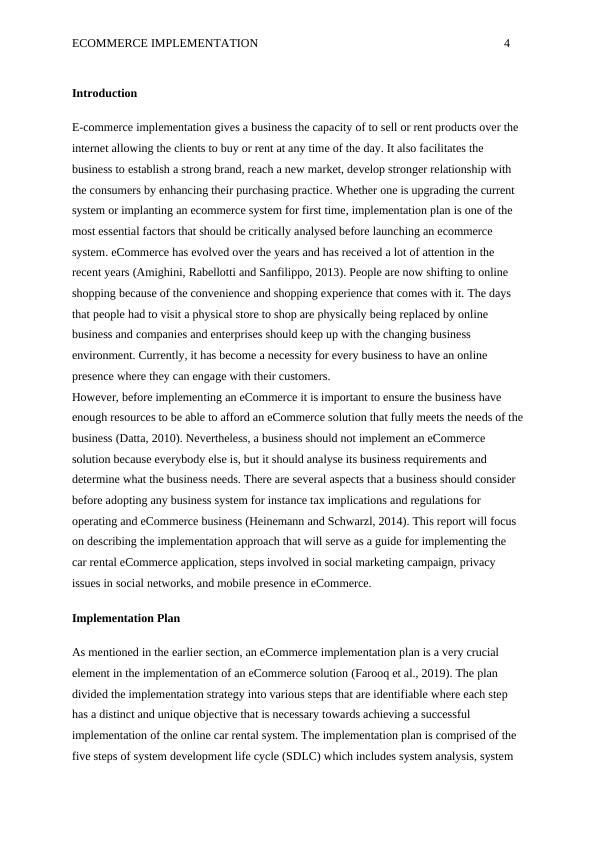Ecommerce Implementation
Added on 2023-03-21
15 Pages5171 Words59 Views
ECOMMERCE IMPLEMENTATION 1
eCommerce Implementation
Student name
Course
Institution
Date
eCommerce Implementation
Student name
Course
Institution
Date

ECOMMERCE IMPLEMENTATION 2
Executive Summary
eCommerce has in the recent years received a lot of attention from a number of businesses.
This is because it allows the business to reach to a wider market segment and make the
services available to the customer at all times, whether day or night. The focus of this report
is on eCommerce implementation where the project will adopt the SDLC development cycle
to implement the eCommerce system. SDLC approach is made up of five key phases
including system analysis, design, development, testing, and maintenance. The second aspect
discussed is the social marketing campaign which is also made up of five steps including
customer acquisition, engagement, amplification, community, and sales or brand strength.
Thirdly, a number of social media privacy issues have been discussed and how to enhance
your privacy while using social media. Finally, the report discusses the importance of mobile
presence and how to achieve it through building a mobile app, mobile website, or a
responsive website.
Executive Summary
eCommerce has in the recent years received a lot of attention from a number of businesses.
This is because it allows the business to reach to a wider market segment and make the
services available to the customer at all times, whether day or night. The focus of this report
is on eCommerce implementation where the project will adopt the SDLC development cycle
to implement the eCommerce system. SDLC approach is made up of five key phases
including system analysis, design, development, testing, and maintenance. The second aspect
discussed is the social marketing campaign which is also made up of five steps including
customer acquisition, engagement, amplification, community, and sales or brand strength.
Thirdly, a number of social media privacy issues have been discussed and how to enhance
your privacy while using social media. Finally, the report discusses the importance of mobile
presence and how to achieve it through building a mobile app, mobile website, or a
responsive website.

ECOMMERCE IMPLEMENTATION 3
Table of Contents
Executive Summary...................................................................................................................2
Introduction................................................................................................................................4
Implementation Plan..................................................................................................................4
System Analysis.....................................................................................................................5
System Design........................................................................................................................5
System Development.............................................................................................................6
System Testing.......................................................................................................................6
System Maintenance..............................................................................................................6
Social Marketing Campaign.......................................................................................................6
Privacy in Social Networks........................................................................................................8
Mobile Presence.......................................................................................................................10
Conclusions and Recommendations to the Business...............................................................11
References................................................................................................................................13
Table of Contents
Executive Summary...................................................................................................................2
Introduction................................................................................................................................4
Implementation Plan..................................................................................................................4
System Analysis.....................................................................................................................5
System Design........................................................................................................................5
System Development.............................................................................................................6
System Testing.......................................................................................................................6
System Maintenance..............................................................................................................6
Social Marketing Campaign.......................................................................................................6
Privacy in Social Networks........................................................................................................8
Mobile Presence.......................................................................................................................10
Conclusions and Recommendations to the Business...............................................................11
References................................................................................................................................13

ECOMMERCE IMPLEMENTATION 4
Introduction
E-commerce implementation gives a business the capacity of to sell or rent products over the
internet allowing the clients to buy or rent at any time of the day. It also facilitates the
business to establish a strong brand, reach a new market, develop stronger relationship with
the consumers by enhancing their purchasing practice. Whether one is upgrading the current
system or implanting an ecommerce system for first time, implementation plan is one of the
most essential factors that should be critically analysed before launching an ecommerce
system. eCommerce has evolved over the years and has received a lot of attention in the
recent years (Amighini, Rabellotti and Sanfilippo, 2013). People are now shifting to online
shopping because of the convenience and shopping experience that comes with it. The days
that people had to visit a physical store to shop are physically being replaced by online
business and companies and enterprises should keep up with the changing business
environment. Currently, it has become a necessity for every business to have an online
presence where they can engage with their customers.
However, before implementing an eCommerce it is important to ensure the business have
enough resources to be able to afford an eCommerce solution that fully meets the needs of the
business (Datta, 2010). Nevertheless, a business should not implement an eCommerce
solution because everybody else is, but it should analyse its business requirements and
determine what the business needs. There are several aspects that a business should consider
before adopting any business system for instance tax implications and regulations for
operating and eCommerce business (Heinemann and Schwarzl, 2014). This report will focus
on describing the implementation approach that will serve as a guide for implementing the
car rental eCommerce application, steps involved in social marketing campaign, privacy
issues in social networks, and mobile presence in eCommerce.
Implementation Plan
As mentioned in the earlier section, an eCommerce implementation plan is a very crucial
element in the implementation of an eCommerce solution (Farooq et al., 2019). The plan
divided the implementation strategy into various steps that are identifiable where each step
has a distinct and unique objective that is necessary towards achieving a successful
implementation of the online car rental system. The implementation plan is comprised of the
five steps of system development life cycle (SDLC) which includes system analysis, system
Introduction
E-commerce implementation gives a business the capacity of to sell or rent products over the
internet allowing the clients to buy or rent at any time of the day. It also facilitates the
business to establish a strong brand, reach a new market, develop stronger relationship with
the consumers by enhancing their purchasing practice. Whether one is upgrading the current
system or implanting an ecommerce system for first time, implementation plan is one of the
most essential factors that should be critically analysed before launching an ecommerce
system. eCommerce has evolved over the years and has received a lot of attention in the
recent years (Amighini, Rabellotti and Sanfilippo, 2013). People are now shifting to online
shopping because of the convenience and shopping experience that comes with it. The days
that people had to visit a physical store to shop are physically being replaced by online
business and companies and enterprises should keep up with the changing business
environment. Currently, it has become a necessity for every business to have an online
presence where they can engage with their customers.
However, before implementing an eCommerce it is important to ensure the business have
enough resources to be able to afford an eCommerce solution that fully meets the needs of the
business (Datta, 2010). Nevertheless, a business should not implement an eCommerce
solution because everybody else is, but it should analyse its business requirements and
determine what the business needs. There are several aspects that a business should consider
before adopting any business system for instance tax implications and regulations for
operating and eCommerce business (Heinemann and Schwarzl, 2014). This report will focus
on describing the implementation approach that will serve as a guide for implementing the
car rental eCommerce application, steps involved in social marketing campaign, privacy
issues in social networks, and mobile presence in eCommerce.
Implementation Plan
As mentioned in the earlier section, an eCommerce implementation plan is a very crucial
element in the implementation of an eCommerce solution (Farooq et al., 2019). The plan
divided the implementation strategy into various steps that are identifiable where each step
has a distinct and unique objective that is necessary towards achieving a successful
implementation of the online car rental system. The implementation plan is comprised of the
five steps of system development life cycle (SDLC) which includes system analysis, system

End of preview
Want to access all the pages? Upload your documents or become a member.
Related Documents
E-commerce Implementation Report & Prototype Websitelg...
|17
|4600
|260
Report on E-commerce Websitelg...
|24
|4031
|19
CIS8100 Assignment - Development of the Website for ERT Companylg...
|18
|5186
|14
Eargasm Website Report 2022lg...
|25
|4808
|15
Building an E-commerce Presence: Strategies and Challengeslg...
|13
|2753
|346
Understanding E-Business: SWOT Analysis, SDLC Methodology, and System Architecturelg...
|3
|789
|408